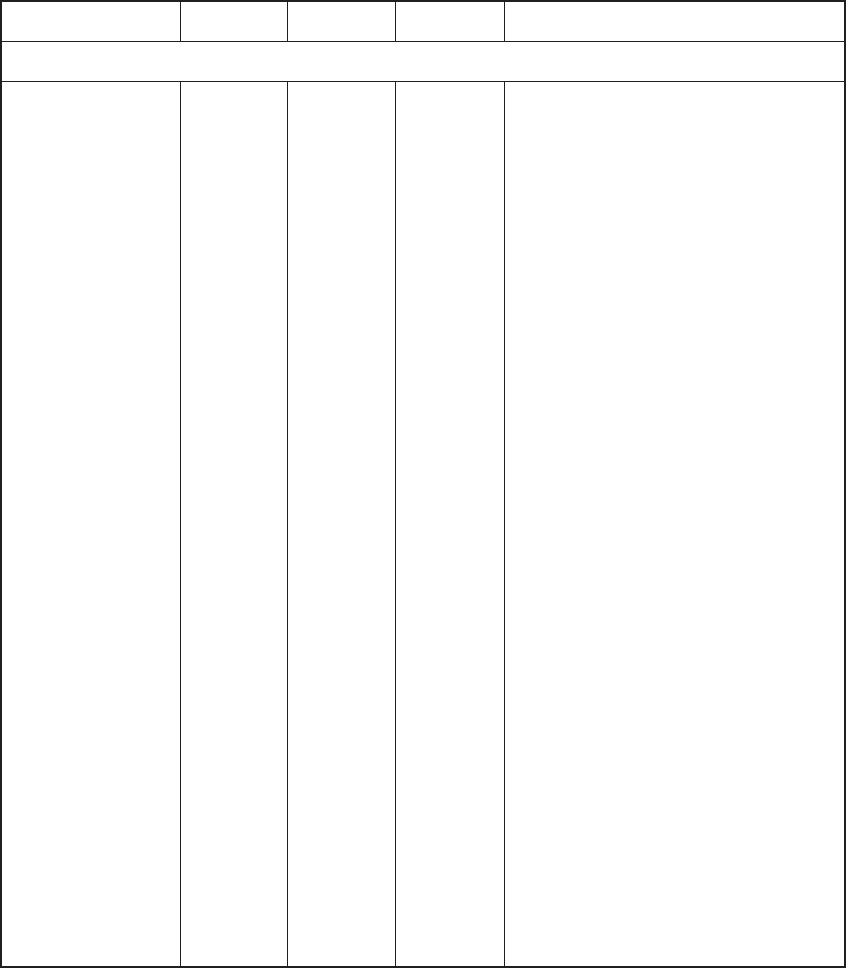
User's Guide
Code Sets D-19
Table D-3. AMT Datasouth and Diablo 630 Escape Sequences––continued
Function ASCII Hexadecimal Decimal Description
Graphic Functions––continued
Print 16-wire graphics The list in the sequence is a series of codes that define the
(continnued) columns to print. The first two codes define the first column, the
second two codes define the second column, and so on. Each bit
in a code controls a specific dot in the column. The most
significant bit controls the top dot, the next bit controls the second
dot, and so on. The most signi-ficant bit of the second code
controls the ninth dot from the top, the next bit controls the tenth
dot, and so on. If the bit is a "1", the dot prints; if the bit is a "0",
the dot does not print. For example, FF FF hex prints all 16 dots in
the column, 00 00 hex prints no dots, 00 FF hex prints the lower
eight dots, and FF 00 hex prints the upper eight dots.
)Note: For more detailed information on these escape
sequences, refer to AMT Datasouth Technical Notes––Graphics,
available separately from AMT Datasouth.
Print 32-wire graphics This sequence prints 32-wire graphics, wherein normal
240V x 240H dpi .................. ESC @ o 1B 40 6F 27 64 111 character codes no longer print characters, but instead print
n1 n2 list n1 n2 list n1 n2 list 32-dot-high columns of dots on the current print line. This
sequence does not change the current line spacing.
Variables n1 and n2 define the number of columns to print.
This number is one-fourth the number of bytes in the list.
The printer interprets n1 and n2 as follows:
Number of columns = (128 x n2) + n1
For example, to print 360 columns of dots, n2 would be 2
and n1 would be 104 (360 = (128 x 2) + 104).
The list in the sequence is a series of codes that define the
columns to print. The first four codes define the first column,
the second four codes define the second column, and so on.
Each bit in a code controls a specific dot in the column. The
most significant bit of the first code controls the top dot, the next
bit controls the second dot, and so on. The most significant bit of
the second code controls the ninth dot from the top, the next bit
controls the tenth dot, and so on. If the bit is a "1", the dot prints;
if the bit is a "0", the dot does not print. For example, FF FF FF FF
hex prints all 32 dots in the column, 00 00 00 00 hex prints no
dots, 00 00 FF FF hex prints the lower 16 dots, and FF FF 00 00
hex prints the upper 16 dots.
)Note: For more detailed information on these escape
sequences, refer to AMT Datasouth Technical Notes––Graphics,
available separately from AMT Datasouth.
User's Guide
Code Sets D-19
Table D-3. AMT Datasouth and Diablo 630 Escape Sequences––continued
Function ASCII Hexadecimal Decimal Description
Graphic Functions––continued
Print 16-wire graphics The list in the sequence is a series of codes that define the
(continnued) columns to print. The first two codes define the first column, the
second two codes define the second column, and so on. Each bit
in a code controls a specific dot in the column. The most
significant bit controls the top dot, the next bit controls the second
dot, and so on. The most signi-ficant bit of the second code
controls the ninth dot from the top, the next bit controls the tenth
dot, and so on. If the bit is a "1", the dot prints; if the bit is a "0",
the dot does not print. For example, FF FF hex prints all 16 dots in
the column, 00 00 hex prints no dots, 00 FF hex prints the lower
eight dots, and FF 00 hex prints the upper eight dots.
)Note: For more detailed information on these escape
sequences, refer to AMT Datasouth Technical Notes––Graphics,
available separately from AMT Datasouth.
Print 32-wire graphics This sequence prints 32-wire graphics, wherein normal
240V x 240H dpi .................. ESC @ o 1B 40 6F 27 64 111 character codes no longer print characters, but instead print
n1 n2 list n1 n2 list n1 n2 list 32-dot-high columns of dots on the current print line. This
sequence does not change the current line spacing.
Variables n1 and n2 define the number of columns to print.
This number is one-fourth the number of bytes in the list.
The printer interprets n1 and n2 as follows:
Number of columns = (128 x n2) + n1
For example, to print 360 columns of dots, n2 would be 2
and n1 would be 104 (360 = (128 x 2) + 104).
The list in the sequence is a series of codes that define the
columns to print. The first four codes define the first column,
the second four codes define the second column, and so on.
Each bit in a code controls a specific dot in the column. The
most significant bit of the first code controls the top dot, the next
bit controls the second dot, and so on. The most significant bit of
the second code controls the ninth dot from the top, the next bit
controls the tenth dot, and so on. If the bit is a "1", the dot prints;
if the bit is a "0", the dot does not print. For example, FF FF FF FF
hex prints all 32 dots in the column, 00 00 00 00 hex prints no
dots, 00 00 FF FF hex prints the lower 16 dots, and FF FF 00 00
hex prints the upper 16 dots.
)Note: For more detailed information on these escape
sequences, refer to AMT Datasouth Technical Notes––Graphics,
available separately from AMT Datasouth.


















